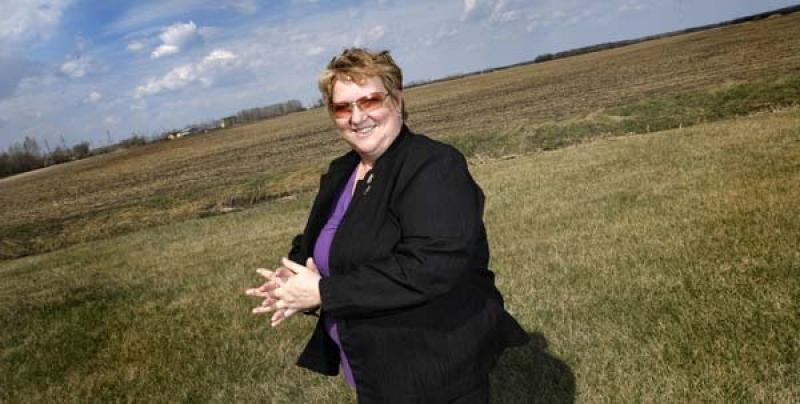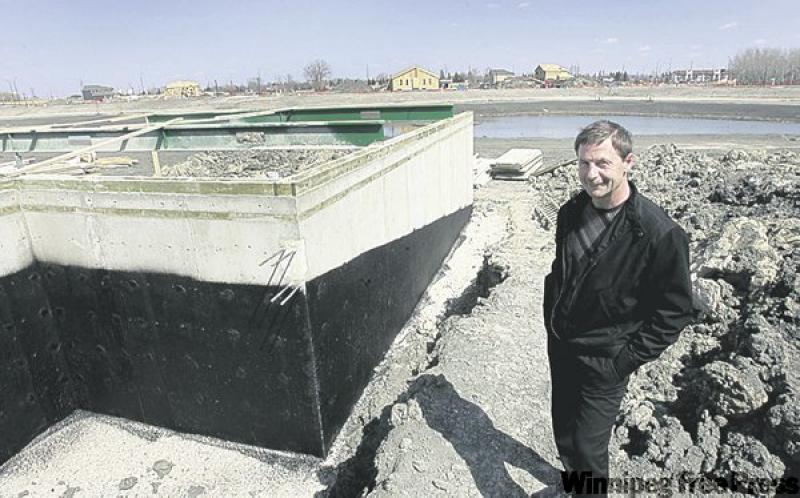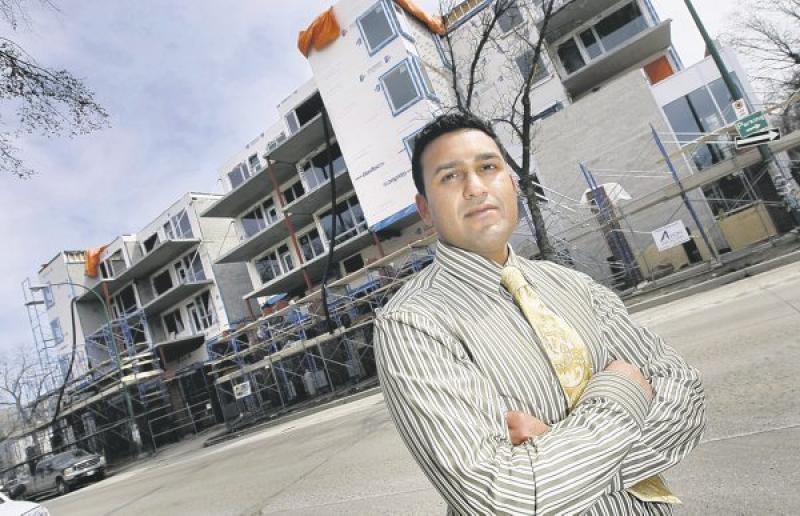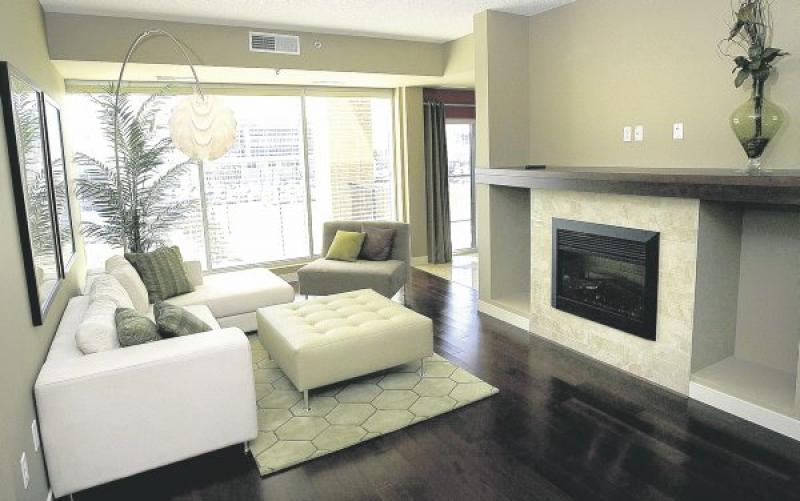New Homes
New Homes
Kid-friendly and cool
CALGARY -- After Erin Ryan-Walsh and her husband Rob Engelhardt moved out of their downtown apartment into a contemporary townhouse, they were thrilled to spend time decorating and adding personal touches to their new home.Relocating their old, inherited furniture into the basement, Erin, a 30-year-old communications specialist and Rob, a 36-year-old financial analyst, happily furnished their new digs with custom furniture and artwork, establishing their first, truly grownup house.
Beautiful framed artwork, hardwood floors and treasured accents that reflect their travels and life together make their home modern, comfortable and elegant. Along with the thrill of adding a pristine ivory linen sofa set to their living room came the exciting news of Erin's first pregnancy. One of Erin's first reactions?
"Oh no, I should have ordered a different couch," she recalls.
Suddenly, the couple was forced to confront a new dilemma: Can we keep our sense of style when the baby arrives?
They're not alone.
More than ever, Canadian couples are waiting until later in life to start a family. Statistics Canada estimates that since 2003, nearly half of Canadian women having their first child were 30 years of age and older. Albertans are no exception: The average age of mothers in the same study was 29.
By the time many couples are welcoming their first baby, it can put those expensive and sophisticated bits and pieces into question.
Nevertheless, Erin and Rob have found there is an advantage to having children later in life.
"We're much more established now," Rob says. "If we were in our 20s having kids, it would be more about what hand-me-downs we could acquire. Erin is picking out artwork to dictate the theme of the baby's room; 10 years ago, I don't think we could have imagined decorating like that."
Stephanie Koo, co-owner of Pink or Blue Couture, a high-end baby shop selling fashionable baby clothes and furniture in Calgary, agrees.
"We target what we like to call the modern-day family. To us, a modern-day parent is in their 30s or 40s, professionals who have good jobs and are just starting their families," says Koo.
"They don't want to decorate with Winnie the Pooh and princesses; they want to paint (their children's room) chocolate brown and have stylish furniture and bedding."
Koo, 25, is a native Calgarian who opened Pink or Blue Couture in August 2007 with her sister, Jennifer Koo Ishigura, 28.
"There are a lot of new, innovative designs that are very streamlined and clean looking and they actually have storage compartments that are hidden," says Koo.
Staying stylish with kids isn't necessarily cheap; customized cribs start at $1,100 and most of the other furniture starts at around $600. Despite the costs, some new parents are not inclined to let children take over their high-style habitats.
Jacqueline Corea is the principal designer for Calgary's Corea Sotropa interior design. Her main clientele consists of homeowners between the ages of 35 to 45, many of them with young children or a baby on the way.
"Some parents allow kids to take over, but most of (our clients) have established a style of living and they don't want their whole life to be completely turned upside down," says Corea.
For most parents, combatting the piles of toys, books and games that children inevitably accumulate is one of the biggest challenges to maintaining a stylish home.
"They (children's toys) are a real eyesore and it's one of the things that parents struggle with," says Corea. "A lot of these toys are massive and they are really bright and don't really co-ordinate with your interior."
Parents certainly don't have to sacrifice style to find storage, as Corea suggests. She recommends finding pieces that "don't look like they came out of a children's store," but instead using a beautiful bureau or armoire, and organizing the toys in the drawers. Choose a coffee table with drawers or an ottoman that flips up and has built-in storage."
Beyond the mountains of toys, the issue of safety often poses a dilemma. Baby-proofing a home is a quick way to relinquish any sense of elegance in the home. Corea has some advice for new parents.
"I think you need to baby-proof to a point; you need to make sure that you get things out of their reach that are dangerous or that you don't want to see broken. The rest of it depends on your comfort level."
Materials and high quality are of the utmost importance for any parent with small children. When buying furniture, Jacqueline Corea suggests choosing fabrics that are patterned or textured, as they hide stains much better than a plain, solid fabric.
"If you're going to have an area rug, get a patterned one for the same reasons. You could invest in a tribal, Afghan rug and that's an exquisite piece of furniture built to last."
Many couples have found a livable balance with the carefree lives that they established when they were childless. Six years ago, Wade Hawkins, 36, a post-secondary instructor, and his wife, Lee-Ann Hawkins, 32, a physician, purchased their first home and worked hard to decorate in style.
"Our living room was the first room that we did, without even thinking about kids," says Lee-Ann. "Just based on what we liked."
As it turns out, one of the key pieces to their living room was an antique-style coffee table with a glass top. "We love solid woods and things that look like they're built to last. We bought the antique-style coffee table with a glass top that flips up and decorated with pieces that went with it."
When Megan, now three, was born, the couple had some initial panic about the safety and durability of their beloved coffee table.
"We had to be cautious with (Megan) obviously, and as she grew up, we had to really enforce the rule that she couldn't slam her toys on it," says Wade.
Before their second child Kiera, now six months old, was born, they renovated the basement to create a more rule-free space -- with the whole thing designed around the kids' comfort and safety.
The couple took their time to create a kid-friendly space that still respects their need to live in a well-designed, adult-looking home. The flooring is resilient and allergen-free hardwood laminate. They installed sconces and pot lights to avoid any standing lamps that could be knocked over. Wiring for TV and stereo was kept behind the walls.
-- Canwest News Service
New Homes
Not for the faint of heart
The old saying goes: It takes money to make money. And nowhere does that apply more than investing in undeveloped real estate.Whether it's to purchase an empty lot to build just one home to sell or to buy a large tract of land, intending to sell when developers come calling, an investor needs cash, experts say.
"It's not for the faint-hearted," says real estate consultant Wayne Penner, an agent for Royal LePage Dynamic.
"It can be a lot of fun. It can be rewarding, but you have to have a strong stomach."
A novice real estate investor has three different options when considering investing in undeveloped land: Large-scale development, small-scale development and speculation -- sitting on the land and selling when it goes up in price.
Buying a large tract of land to develop commercial real estate, several homes or a condominium project is amongst the most costly, requiring experience, and often presents the most headaches.
"The problem is with all the red tape and things that go with trying to develop it within the city," Penner says.
"You have to have it rezoned. You're going to have to have an extensive plan. You're going to have public hearings. You're going to be fighting with residents in the area who may not want the project there because all they've seen is grass, meadow and trees."
On average, a developer will spend more than a year of planning, negotiating and ensuring all the zoning and permits are in place before even a shovel touches the ground.
"On top of that, what are the construction costs, and what are servicing costs? This is a full-time job," says Penner, who has 35 years of experience in the Winnipeg market, and is currently working with one client who is a novice developer.
"If you bought the land, of course, time is ticking and interest rates are OK, but the bank needs to be fed."
For most average, middle-class Winnipeggers, developing land on a large scale is simply beyond their financial means, says Gerry Campbell, executive vice-president of sales and service with the Assiniboine Credit Union.
Often millions of dollars are involved even for the smallest condominium project.
"That's risky. It takes a fair bit of resources," he says, adding he does not see many clients engaging in this sort of real estate venture.
"They have to have a lot of financial resources behind them if they're looking for a larger tract of land."
On top of that, a would-be developer may be on the hook for infrastructure.
"There has to be the sewer, the water, the road, the hydro. That's a big capital investment. So, do they have wherewithal behind them to take that sort of thing on?"
Mortgage broker for Invis Rosa Bovino says most lenders would want anything from 35 to 50 per as a down payment from the buyer in order to finance the venture.
"We have several clients looking to purchase land, some to be subdivided and sold," she says.
"A lot of people don't have they means of coming up with that kind of money."
For the novice, Campbell suggests starting out small.
"Let's say I wanted to buy a vacant lot on the street that I already live on, and just want to put a house on it and sell it to someone else, what we would need is 35 per cent cash into it," he said, adding one way to fund the down payment would be to use the equity built up in your home.
Though it can work, and become the first step onto bigger and better projects, it also has real risks. It can take time to build the home, which means during that period, the developer must carry the cost of both the mortgage's and line of credit's interest payments. Property taxes are another expense, and construction costs in a tight market for both supplies and labour are perhaps and even bigger concern.
The builder must also find a buyer. Although the market is hot now, it may not be a year from now.
The stakes are high: The builder's own home is on the line, Campbell says about using home equity to back the project.
"We would likely put what we call a caveat against the house -- kind of a lien against it -- so that we would be covered if they were unable to repay," he says.
"If they couldn't pay, we could force them to sell the house to recover our funds that way."
As risky as that may seem, it pales in comparison to real estate speculation.
"Speculation is the most volatile aspect of real estate investment," says Sandy Shindleman, president of the commercial real estate company, Shindico.
"There's no income stream and, typically, to bring the property to an income stream potential, either you have to make a substantial additional investment, or you need to sell it."
Shindleman, whose company does provide consultation services to people looking to purchase and develop land for commercial use, says many people have bought land in the past 60 years on the edge of Winnipeg, hoping to sell it when developers came calling but, instead, found little success.
A buyer must also know that speculation takes time and patience. More often than not, it involves holding on to the land for 10 to 20 years.
"You have to be able to understand what is in the immediate path of development, and what political issues at the municipal or provincial level might impede the development of the property."
It also requires a good grasp of regional economics. The job market ultimately will drive development. The more jobs available in a community, the greater the need for housing and services associated with the growth of new communities.
"It's not the first thing they should try," he says, adding speculation does have one advantage over other forms of real estate investment.
"It's certainly easy to manage if there's no rent and no tenants. It's simply a matter of cutting the grass and making sure you have liability insurance."
Above all, as with all forms of real estate investment, the novice should seek advice. Talk to a banker, mortgage broker, the city's planning and development department and real estate consultant before spending any money at all.
"You have to have your eyes open when you go in because there's always that chance that things could change," Campbell says.
"Can you accept the consequences or ride it out if the market has a change of pace?"
Quick tips
for investing
in bare land
Start out small: Buying one lot for single-family use is often all that the average investor can afford and should be willing to risk.
Experience needed: If you don't have it yourself, seek it out before spending any money. Real estate agents, your bank or credit union, the City of Winnipeg, mortgage lenders and even developers are valuable sources of information.
Greater profits mean higher risks: Investing in undeveloped property is the riskiest of all real estate ventures. It's also costly. Ensure beforehand you are aware of what you stand to lose if it doesn't work out as planned. The bigger the investment means the more you stand to make, but you also stand to lose more -- if not everything.
New Homes
Sit back and relax
To many seniors, retirement means retiring from work, not life.More than ever, today's retirees lead an active lifestyle. However, with retirement also comes the desire to come home to a place that doesn't require endless hours of upkeep -- yet offers space and style. Enter Sturgeon Creek II Retirement Residence, 707 Setter St., in St. James (across from Grace Hospital).
"The concept here is that we will present you with the finest amenities and services to enrich your retirement years," executive director Terri Hammerback said.
"There are 153 one- and two-bedroom suites here, and we provide all your meals, do weekly housekeeping, your laundry and offer a wide variety of activities. The suites are rentals; rent for one-bedroom suites ranges from $1,975 to $2,460, while rent for two bedrooms ranges from $2,975 to $3,200 depending on the plan you choose."
Although compact, both the one- and two-bedroom suites are well laid out, making the best possible use of space available. The two-bedroom display suite viewed measured in at 640-square-feet, yet felt much larger due its floor plan, high ceilings (over nine feet) and large windows.
A large, bright sitting area with fridge and sink, and two large bedrooms down the hallway -- each equipped with its own bathroom -- mean there is ample space, privacy and access.
"This suite represents one of seven different styles," Hammerback said. "They all have a fridge, sink and moderate amount of cupboard space -- many residents like to have breakfast in their suite. In most cases, we don't expect people will cook as all meals and snacks are included. The bedrooms are a good size, and have wheelchair-accessible bathrooms with features like low bathtubs, walk-in showers with handshowers and grab bars. There's also plenty of storage space with two double closets and a broom closet in two-bedroom units."
Single seniors can also rest easy knowing that the one-bedroom suites offer the room and creature comforts they need -- all at reasonable, all-inclusive price.
"We're proud of the way the suites have been designed. This one-bedroom unit (a 570-square-foot display model) is a very neat design. It's angular, with a huge storage closet at front, big sitting area with fridge, sink and cupboards, and a large bedroom that's adjacent to a large, user-friendly ensuite," she said.
Staff is on call 24 hours a day to ensure comfort and safety, she added.
"From what we've been told by residents, it's all a single person needs in terms of size and amenities. Smaller one-bedroom suites are also available."
While the suites at Sturgeon Creek II are eminently livable, the real focus at the facility is on what residents are going to do outside their home. Consequently, the complex has been finished with oak trim, eye-pleasing pastel colours and many amenities.
"The focus here is one providing an environment that encourages both relaxation and activity," Hammerback said.
"We have a full-time activity co-ordinator on staff, and there are amenities such as recreation and fitness rooms, a games and billiards room, hobby and craft room, movie theatre and shuttle bus for outings."
The residence features elements aimed at kicking back in style.
"There's lots -- a tranquil library, Internet lounge, main-floor bistro and coffee lounge with fireplace, spa, and beauty salon/barber shop. Services such as weekly linen and towel service, dry cleaning pick-up and delivery and laundry facilities on each floor really make for retirement living with a touch of luxury. When you eat lunch and dinner in the elegant dining room (which offers a separate dining area for parties or family functions), it feels like you're treating yourself," she said.
"And that's how it should be. People have worked hard, so they should enjoy themselves," she added.
With an excellent location, spacious and secure suites, and a host of amenities, active seniors looking for a new place to call home should consider taking a tour of Sturgeon Park II Retirement Residence.
lewys@mts.net








